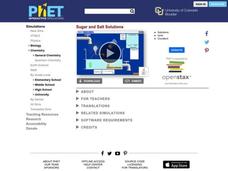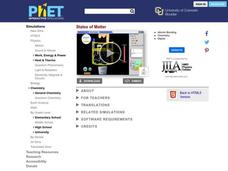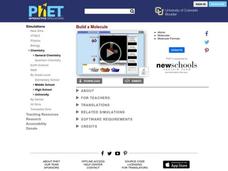PhET
Sugar and Salt Solutions
Ionic bonds form from electrostatic energy, allowing for higher conductivity than those seen in covalent bonds. In the simulation, learners add sugar and salt to water and see the effects on concentration and conductivity of their...
PhET
States of Matter
Water is the only molecule on Earth that can naturally exist in all three states of matter. The interactive simulation shows different molecules changing states of matter with the addition or removal of heat. Learners then see how...
PhET
Reactants, Products and Leftovers
Did you know when you mix the reactants sulfur, tungsten, and silver, you get the products SWAg? The simulation begins with making sandwiches, to show pupils reactants and products of something familiar. They then can make water,...
PhET
Radioactive Dating Game
Uranium 235 has a half-life of over 700 million years and is the fuel used in the atomic bomb dropped on Hiroshima, Japan. Pupils see the half-lives and decay rates of Carbon-14 and Uranium-238. They also take measurements of these two...
PhET
Isotopes and Atomic Mass
Some isotopes are unstable, or radioactive, meaning they will decay over time and turn into another isotope or stable element. In the interactive simulation, participants manipulate elements to create isotopes and gather information....
PhET
Molecule Shapes: Basics
In molecules, bonds rotate about the nucleus due to the repulsion of subatomic particles. In a simulation, learners manipulate the bonds of a molecule to meet the atoms' needs. They can then see the specific molecular shapes of five...
PhET
Build a Molecule
How many different molecules can you build? In a simulation, learners make molecules from given atoms. There are numerous collections from which to build three to five molecules from given kits of atoms. Scholars can also view their...
Scholastic
Study Jams! Transformations
Flip, spin, and shift with this vocabulary-rich video on transformations. Learners watch different movements and see how to move an object without affecting its size. The video follows with a multiple choice assessment that...
Scholastic
Study Jams! Classify Triangles
Jam on with this multi-faceted activity teaching triangle classification. Start with a learner-paced lesson describing the different qualities of triangles and follow with a fun karaoke session. Also provided are two types of...
Scholastic
Study Jams! Elapsed Time
Identify the larger number, place the smaller number on the bottom, and then subtract in order to determine elapsed time. Animated slides of each step are also narrated by a friendly voice to teach elementary math minds how to solve such...
Scholastic
Study Jams! Tell Time
Third graders learn to read an analog clock to the minute by going through this interactive presentation. They view animated slides, try it themselves, and review vocabulary, all within the same website.
Scholastic
Study Jams! Circle Graph
Over a pizza dinner, RJ and Mia discuss how to use a circle or pie graph to represent data. After viewing, data analysts can use a Test Yourself feature to assess their own understanding. This is ideal for use in a flipped classroom lesson.
Scholastic
Study Jams! Bar Graphs
Mia teaches Sam how to create a bar graph, including forming a title, creating and labeling the axes, choosing a scale, and entering data. After viewing, data analysts can test themselves with seven follow-up questions and review...
Scholastic
Study Jams! Units of Measurement
As Mia and RJ discuss measurement, your class is introduced to the customary and metric systems for measuring mass, capacity, weight, and length. Temperature scales are also introduced. This resource can help set the foundation for later...
Scholastic
Study Jams! Identify Missing or Extra Information
Learn to maneuver through word problems by identifying the specific information needed to solve it. Is there unnecessary information? Is there missing information?
Scholastic
Study Jams! Add & Subtract Measurements
How much leopard print fabric will Zoe need to upholster a sofa for her jam studio? This problem is the example used to teach how to add and subtract measurement-related values.
Scholastic
Study Jams! Perimeter
Follow this engaging slide show on the calculation of polygon perimeter with some hands-on measurement of perimeters to solidify the concepts. On this webpage there are interactive assessment questions and links to related resources by...
Scholastic
Study Jams! Convert Units of Time
How many seconds are in a minute? Or rather, how many seconds are in eight minutes? This problem is worked out through a series of animated steps and explained by a friendly young lady's voice. Your time travelers will appreciate this...
Scholastic
Study Jams! Estimate Whole Numbers
Watch animated slides as RJ explains how to round numbers to the nearest ten and thousand. Viewers then get a chance to try it themselves.
Scholastic
Study Jams! Newton's First Law: Inertia
Give your class some inertia with a far out video and multiple-choice questions about Newton's first law of motion. Several examples are given in an animated feature in a style that upper-elementary learners will enjoy.
Scholastic
Study Jams! Multiplication of Decimals
How do you handle a decimal point when it appears in a multiplication problem? The answer is explained with a captivating and interactive slide show.
Scholastic
Study Jams! Place Decimal on a Number Line
Through four steps, three different time values for a 100-meter run are arranged on a number line in order to practice ordering decimal numbers. The price of two sports drinks are also compared. All of this comes in narrated and animated...
Scholastic
Study Jams! Addition & Subtraction of Decimals
So current with preteens is the topic of downloading tunes into their computers! In a relatable lesson, viewers are taught to figure out if Zoe can afford to purchase two songs if she has $3.00 left to her credit. Mia talks them through...
Scholastic
Study Jams! Place Value of Decimals
Here is a clear explanation of decimal place value using batting average as the example. Narrated and animated steps are clicked on so that learners can progress at their own pace. Consider having fifth graders interact with this website...









